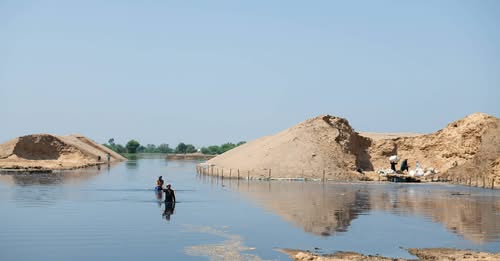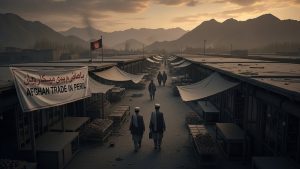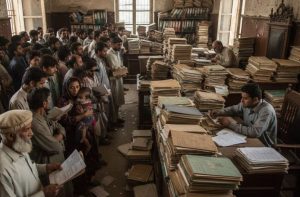Monsoon chaos has once again gripped Pakistan, reminiscent of the devastating 2022 floods that submerged one-third of the country and destroyed infrastructure and communities. The worsening urban water crisis further complicates this situation. Cities like Islamabad, Rawalpindi, and Lahore are facing declining groundwater levels due to rapid urbanisation. Instead of recharging aquifers, rainwater rushes into sealed drains and narrow nullahs, many of which are clogged or encroached upon, turning streets into flood zones.
The danger is not merely theoretical. In July 2021, a sudden cloudburst dropped over 100 mm of rain in Islamabad’s E-11 sector, leading to devastating flash floods that resulted in the deaths of two people when their home basements were inundated. Satellite imagery later confirmed that the illegal narrowing of the natural nullah by housing developments had blocked water flow, worsening the flooding.
The human cost of this monsoon continues to rise. Reuters reports that Punjab experienced at least 63 more deaths in a single day, bringing the national total to 159. Al Jazeera confirms that fatalities have now surpassed 180, with children tragically making up over half of the deceased.
Northern Pakistan has not been spared either. In Gilgit-Baltistan, glacial lake outburst floods have destroyed villages and blocked tourist routes, while flash floods have trapped dozens of tourists, prompting large-scale rescue efforts.
These are not future risks; they are now.
From Runoff to Recharge: Seizing the Rescue Opportunity
Islamabad experiences between 1,400 and 2,100 mm of annual rainfall; however, much of this water is lost as surface runoff. Without proper intervention, excessive rainfall overwhelms drainage systems, leading to flooding and resulting in water flowing away unused. Recognising the potential to turn this challenge into an opportunity, the International Water Management Institute (IWMI), in collaboration with the Pakistan Council of Research in Water Resources (PCRWR) and WaterAid, established a demonstration groundwater recharge well at Kachnar Park in 2022.
This innovative system channels rainwater deep into the aquifer, utilising rain gauges, flow meters, and real-time sensors to monitor the recharge process. It addresses two critical challenges simultaneously: reducing urban flooding and replenishing depleted groundwater reserves.
The need for such measures has never been more urgent. This year’s monsoon rains have been unusually intense, causing sustained downpours that overwhelm drainage systems and inundate low-lying areas. Without recharge systems like the one at Kachnar Park, much of this valuable water would be wasted as runoff. Since its establishment, the site has diverted an estimated 19 million gallons of stormwater underground, relieving pressure on the city’s drainage system and directly improving groundwater levels in nearby Sector I-8, where residents have reported that previously dry boreholes are now functioning again—evidence of improved water tables due to the recharge system.
The success of this model was already evident during the 2022 monsoon season, when the well delivered 1.9 million gallons back to the aquifer, raised the water table by approximately four meters, and reduced flood peaks in Nala Lai.
Scaling Up: The Road Ahead
Encouraged by this success, the Capital Development Authority (CDA) has replicated the model by establishing 50 similar recharge sites across Islamabad, with plans to expand to 100 sites. Collectively, these wells returned nearly 10 million gallons of rainwater to underground storage during the 2022 monsoon season.
These are more than engineering projects; they are nature-based solutions designed for local realities and built with the community in mind. If implemented at scale in other urban centres, such systems could transform Pakistan’s approach to monsoon rains, preventing flash floods and storing water for dry months ahead.
Governance—the missing piece in water strategy
Technology alone isn’t enough. Pakistan’s fragmented water governance, with separate bureaucracies overseeing surface, stormwater, and groundwater, undermines integrated management. As a result, rainwater now flows into roads and sewers instead of replenishing aquifers.
For a pilot like Kachnar Park to become a citywide norm, policies must mandate rainwater harvesting, include recharge wells in municipal bylaws, and coordinate agencies across water domains. Without systemic reform, even practical projects remain isolated victories.
Choosing Resilience Over Routine Disaster
Year after year, the destruction caused by monsoons has become a grim routine. However, the successful implementation of the Kachnar Park recharge well shows that rainwater can be collected, stored, and transformed into a valuable water reserve. To expand this vision, we need city-level planning, municipal regulations that require recharge infrastructure, and community-driven water governance.
The choice is clear: we can either prepare for the worst every monsoon or create a future where every drop of rain is utilised effectively. If Pakistan can turn rain into resilience, the monsoon season has the potential to become a time of replenishment rather than ruin.
Disclaimer: The views and opinions expressed in the article belong solely to the author, and not necessarily to the author’s employer, organisation, or other group or individual.














